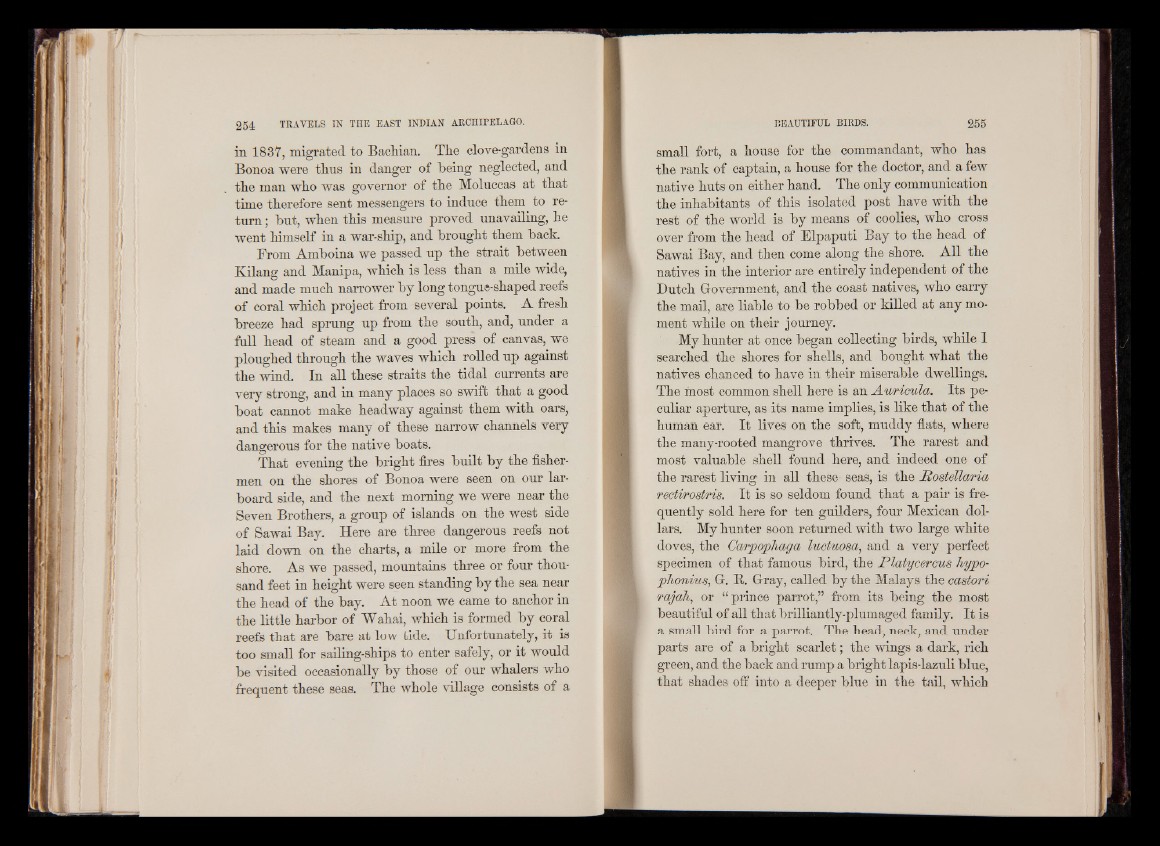
in 1837, migrated to Bachian. The clove-gardens in
Bonoa were thus in danger of being neglected, and
the man who was governor of the Moluccas at that
time therefore sent messengers to induce them to return
; but, when this measure proved unavailing, he
went himself in a war-ship, and brought them back.
From Amboina we passed up the strait between
TTilaug and Manipa, which is less than a mile wide,
and made much narrower by long tongue-shaped reefs
of coral which project from several points. A fresh
breeze had sprung up from the south, and, under a
frill head of steam and a good press of canvas, we
ploughed through the waves which rolled up against
the wind. In all these straits the tidal currents are
very strong, and in many places so swift that a good
boat cannot make headway against them with oars,
and this makes many of these narrow channels very
dangerous for the native boats.
That evening the bright fires built by the fishermen
on the shores of Bonoa were seen on our larboard
side, and the next morning we were near the
Seven Brothers, a group of islands on the west side
of Sawai Bay. Here are three dangerous reefs not
laid down on the charts, a mile or more from the
shore. As we passed, mountains three or four thousand
feet in height were seen standing by the sea near
the head of the bay. At noon we came to anchor in
the little harbor of Wahai, which is formed by coral
reefs that are bare at low tide. Unfortunately, it is
too small for sailing-ships to enter safely, or it would
be visited occasionally by those of our whalers who
frequent these seas. The whole village consists of a
con all fort, a house for the commandant, who has
the rank of captain, a house for the doctor, and a few
native huts on either hand. The only communication
the inhabitants of this isolated post have with the
rest of the world is by means of coolies, who cross
over from the head of Elpaputi Bay to the head of
Sawai Bay, and then come along the shore. All the
natives in the interior are entirely independent of the
Dutch Government, and the coast natives, who carry
the mail, are liable to be robbed or killed at any moment
while on their journey.
My hunter at once began collecting birds, while 1
searched the shores for shells, and bought what the
natives chanced to have in their miserable dwellings.
The most common shell here is an Auricula. Its peculiar
aperture, as its name implies, is like that of the
human ear. It lives on the soft, muddy flats, where
the many-rooted mangrove thrives. The rarest and
most valuable shell found here, and indeed one of
the rarest living in all these seas, is the Rostella/ria
recti/rosl/ris. It is so seldom found that a pair is frequently
sold here for ten guilders, four Mexican dollars.
My hunter soon returned with two large white
doves, the Carpophaga luctuosa, and a very perfect
specimen of that famous bird, the JPlatycercus hypo-
phonius, G. B. Gray, called by the Malays the castori
rajah, or “ prince parrot,” from its being the most
beautiful of all that brilliantly-plumaged family. It is
a small bird for a parrot. The head, neck, and under
parts are of a bright scarlet; the wings a dark, rich
green, and the back and rump a bright lapis-lazuli blue,
that shades off into a deeper blue in the tail, which